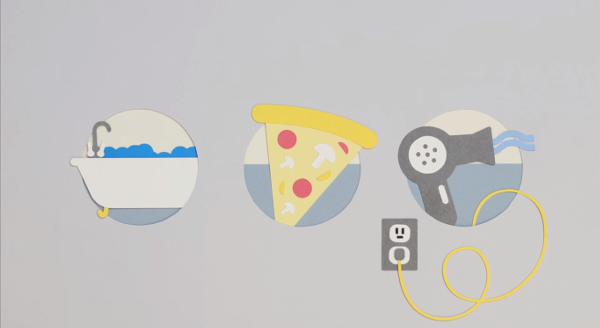People and the Water Nexus
Introduction
People impact the Alberta Water Nexus in many ways. We are directly connected to the Nexus through the taps in our home, the energy we use, and the food we eat. People use water when they take showers, wash dishes and clothes, irrigate lawns, and any other activity that involves a household water supply. Municipalities supply water to most households in Alberta, and have an important role in the Nexus, being the third largest allocation of water in Alberta, behind cooling and irrigation. Municipalities constitute approximately 11% of total water allocation1.

Because most of Alberta’s population lives in the southern half of the province and water supplies are more abundant in the north, there is a mismatch between water supply and demand. This mismatch will become even more significant in the future as urban populations increase. However, many options are available for households to reduce their water consumption, and many municipalities are implementing water conservation plans to protect the environment and maintain the reliability of water supplies.
Although municipalities have a large proportion of the allocated water in Alberta, it is important to note that not all water withdrawn for municipal use is consumed by people. Water that goes down the drain has been withdrawn by people but is usually then treated and returned to the system for other users downstream, including the environment.
How is water used by people?
Water is used for various household and gardening activities. In Calgary, the average person uses about 7000 litres of water per month2. Although much of this water is returned to the environment, reducing this amount by even a few litres a day can add up to millions of litres saved by the entire population.
For most Albertans, the water that comes out of the tap at home is provided by a municipal water distribution system, which takes water from local surface water sources under a municipal license. Water taken under a municipal licence is typically first treated to drinking water quality standards and then distributed to households, businesses, and light commercial industries. Read more about drinking water treatment here. Some rural area residents, on-reserve Indigenous communities, and homes not connected to public or municipal treatment systems have a private water supply system that is not part of a municipal water license but may take water from the same source.
Water that goes down the drain at home is typically treated at a municipal wastewater facility, where contaminants and organic matter are removed. Once treated, the treated water, or effluent, is returned to the river system as “return flow”, and can be reused by other water users, or the environment, downstream of the treatment plant.
People also impact the Nexus by creating demand for food and energy, thereby increasing the production and consumption of both. Almost every decision a homeowner makes, like turning on the tap, using electricity, or buying food at the store, impact the Water Nexus in Alberta.
How can water use be minimized in the people sector?
People can reduce their water consumption (and their water bill!) by:
- Installing water-saving fixtures like low-flow shower heads, dual-flush toilets, or low-flow faucets.
- Upgrading appliances to newer models that are more water efficient.
- Installing lawn irrigation systems that use water more efficiently.
- Reducing the duration or frequency of water consuming activities (i.e. baths, watering the lawn).
Explore the impact of everyday water decisions and learn more ways to save water by taking our quiz here.
Broader scale water conservation programs help implement water conserving strategies like those listed above through larger scale, coordinated efforts. Community or municipal water conservation programs can include strategies for reducing residential, commercial and industrial water demand, from repairing water distribution systems to minimize loss from leaks, to installing water meters, or exploring unique reuse programs within their jurisdiction.
People and the Nexus Simulator
The Alberta Water Nexus simulator is an engaging tool that asks users to make decisions regarding water use in the Bow River Basin in the year 2030. Users are then able to view the impact of those decisions on our water resources. The simulator uses real-life examples from the major consumers of water in the Bow River Basin including the food and energy sectors, and people.
In the Nexus simulator, people are household water users making decisions about water use at home. For instance, users can decide how they water their lawn, and select whether they have a dual flush toilet and low flow showerhead. The simulator then scales up their response to show what municipal water use would look like in the Basin if every household made the same choices as they did.
Connections in the Water Nexus
Everyone and every sector in the Alberta Water Nexus shares a common water supply. This supply is limited, and quality and quantity vary on a year by year basis, making it especially important to plan in advance for how to best share the water. All the sectors in the Nexus are connected, therefore balancing water between them can be complicated. Actions in the Water Nexus also have cascading impacts into other parts of our society like the economy, our health, and social issues. These cascading impacts can be both positive or negative.
Learn more about the connections of the Nexus by clicking here.
Sources:
AMEC Earth & Environmental. (2007). Current and future water use in Alberta. Alberta Environment. Retrieved from http://www.assembly.ab.ca/lao/library/egovdocs/2007/alen/164708.pdf
Calgary Water Services. (2010). Water use in the home. Retrieved from http://www.calgary.ca/UEP/Water/Pages/Water-conservation/Indoor-water-conservation/Water-Use-in-the-Home.aspx
AUMA. (2014). 2014 Urban Municipal Water Conservation, Efficiency and Productivity Plan – Targets and Actions for the Urban Municipal Sector, (July), 1–17. Retrieved from http://www.auma.ca/live/digitalAssets/80/80674_2014_CEP_Plan.pdf
